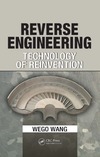The process of reverse engineering has proven infinitely useful for analyzing Original Equipment Manufacturer (OEM) components to duplicate or repair them, or simply improve on their design. A guidebook to the rapid-fire changes in this area, Reverse Engineering: Technology of Reinvention introduces the fundamental principles, advanced methodologies, and other essential aspects of reverse engineering.
The book’s primary objective is twofold: to advance the technology of reinvention through reverse engineering and to improve the competitiveness of commercial parts in the aftermarket. Assembling and synergizing material from several different fields, this book prepares readers with the skills, knowledge, and abilities required to successfully apply reverse engineering in diverse fields ranging from aerospace, automotive, and medical device industries to academic research, accident investigation, and legal and forensic analyses.
With this mission of preparation in mind, the author offers real-world examples to:
- Enrich readers’ understanding of reverse engineering processes, empowering them with alternative options regarding part production
- Explain the latest technologies, practices, specifications, and regulations in reverse engineering
- Enable readers to judge if a "duplicated or repaired" part will meet the design functionality of the OEM part
This book sets itself apart by covering seven key subjects: geometric measurement, part evaluation, materials identification, manufacturing process verification, data analysis, system compatibility, and intelligent property protection. Helpful in making new, compatible products that are cheaper than others on the market, the author provides the tools to uncover or clarify features of commercial products that were either previously unknown, misunderstood, or not used in the most effective way.
 |
|
О проекте
|
|
О проекте


